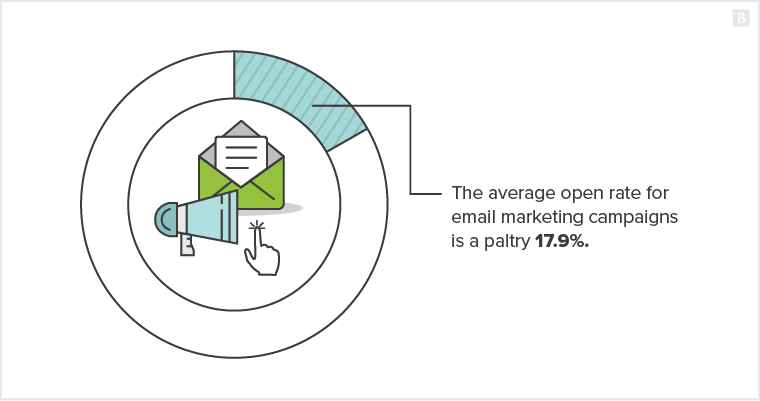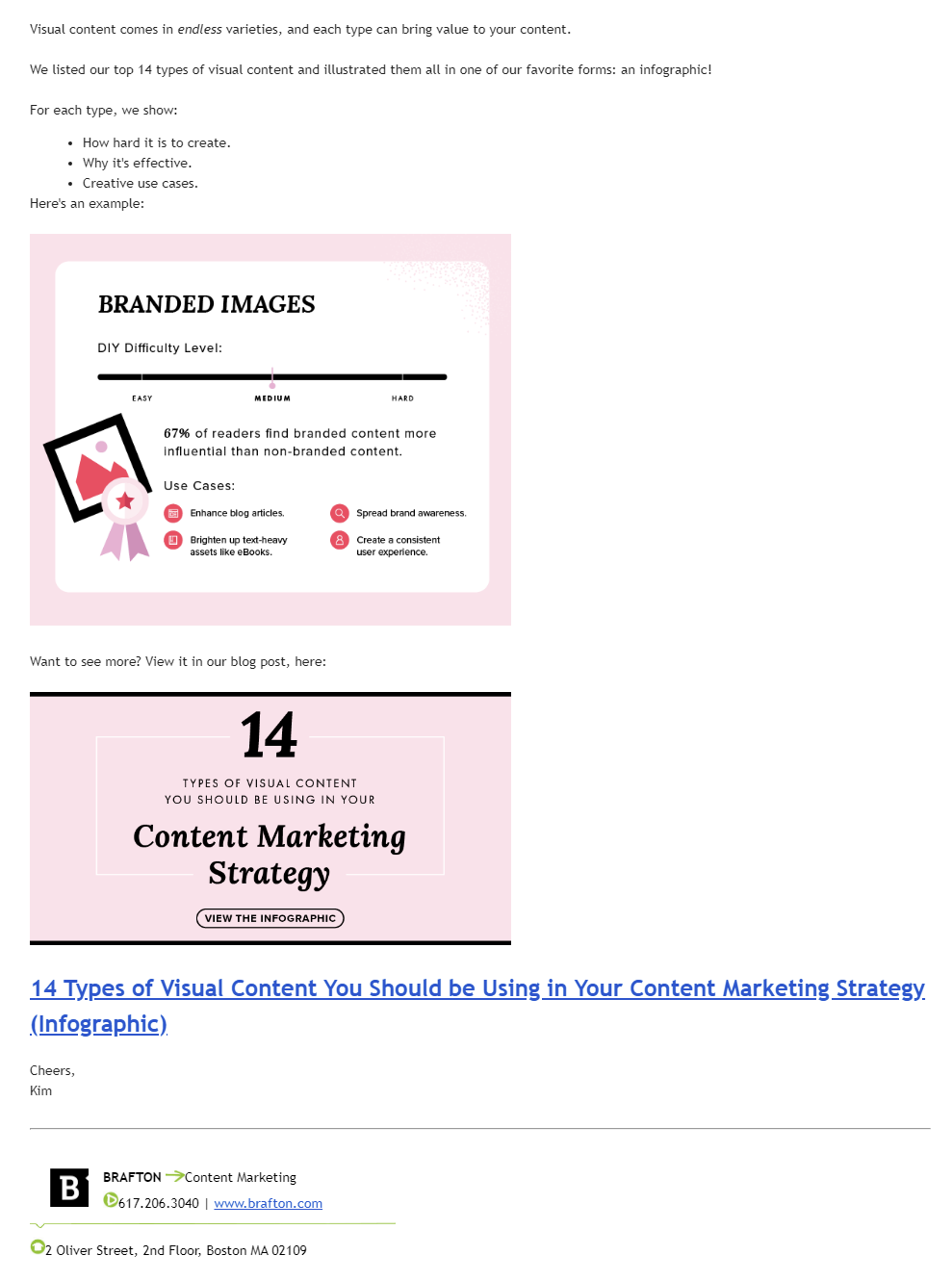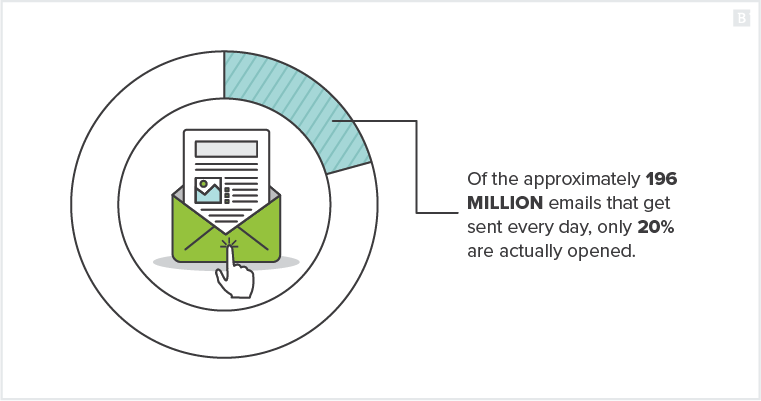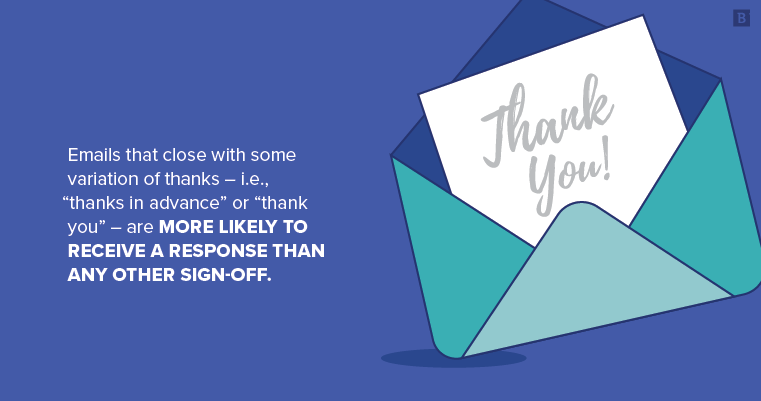If you’re looking for ROI in your digital marketing strategies (and who isn’t?), then email needs to be a part of your plan.
Email is arguably the most important form of communication in business today, and the right email marketing strategy can pay big rewards in terms of engagement, lead nurturing, conversions and other key metrics. In fact, 73% of marketers say that email is the best digital channel for generating tangible ROI.
To really capitalize on email marketing’s potential, you need to craft compelling and engaging professional emails.
Take a page from these examples and follow their professional email writing tips and tricks.
6 professional email writing tips:
- Start with an attention-grabbing subject line
- Use a conversational greeting
- Keep it short and sweet
- Balancing style and tone with your target audience
- Give a warm farewell
- Don’t forget your email signature
1. Start with an attention-grabbing subject line
Let’s be honest, the vast majority of recipients are not going to open your marketing emails.

The average open rate for email marketing campaigns is a paltry 17.9%.
You can boost your odds, however, by crafting a subject line that actually resonates with your target audience.
People have become pretty discerning when it comes to quickly spotting emails that are relevant to them and those that can be swiftly sent to the trash folder. If you come on too strong at the outset, you’ll find yourself in the latter camp.
Subject lines should be concise and to the point.
Get a little too verbose in your email subjects, and the whole thing won’t even appear in the recipient’s inbox.
Subject lines should be concise and to the point.
There is such a thing as too much brevity, however. If a sales prospect can’t get a good sense of what the body of an email contains just by reading the subject line, then they probably won’t open it.
Welcome to the 82.1%.
Your subject lines should offer something valuable to the reader.
Maybe it’s advice on how to solve a common problem in their industry or a discount on products – whatever it is, the recipient should feel that they’re about to get something in return for opening your email.
Another approach to crafting engaging subject lines is to pique your audience’s curiosity.
Thought-provoking headlines are more likely to intrigue recipients and can improve your open rates. The key is to not give too much away up front. If the subject line tells the reader everything they need to know without even having to open the email, then why bother clicking on it?
It’s all about finding that happy medium between telling your audience what they need to know up front and giving them a compelling reason to keep reading.
Whatever you do, stay away from clickbait subject lines. No one is going to take you seriously if you resort to those kinds of tactics.

2. Use a conversational greeting
Arguably the biggest mistake people make with any kind of professional writing is to veer too hard into formality.
Professional does not equal stuffy.
If you want to come across as genuine, you’re going to have to ditch the “Dear {blank}” greeting.
I know, I know, everyone and their grandmother were taught to open any letter or email with “Dear,” but it comes across as incredibly stiff in the age of the emoji.
Professional does not equal stuffy.
Kicking off a professional email with a simple “Hi” shows customers and prospects that it was actually written for them by a real person who didn’t pick up all of their business writing etiquette pointers back when typewriters ruled the world.
If you want to get even more conversational, “Hey” works too. Some people might find that a little too familiar, so as always, know your audience.
There are some instances where you’ll want to drop the greeting altogether.
Certain newsletter templates don’t really require an intro because they speak for themselves or lean on graphics to tell their stories. Take this example, for instance – we began the email without a greeting, but let the visuals grab reader attention:

If you’re not sure what your target goes by – for instance, “Mike” vs. “Michael” – it might be better to lose the greeting and avoid calling them by the wrong name. It’s a simple mistake, but all of your efforts to come across as casual and friendly could blow up in your face if you get it wrong.
3. Keep it short and sweet
Of the approximately 196 million emails that get sent every day, only 20% are actually opened.
With those odds, just getting your sales prospects to click on your emails should be a win, right?

Measuring the success of your email campaigns by open rate is kind of like judging your content marketing strategies on the basis of organic site traffic alone. All it really tells you is how many people saw your content. What it won’t tell you is if they actually listened.
That’s why many industry experts view click-to-open rate (CTOR) as the best email marketing metric to use. That’s not to be confused with your click-through rate (CTR), which measures how many recipients actually clicked through some element of your email. CTOR is similar to CTR, except it’s limited to the people who opened your email rather than the total number of recipients. It’s a bit more granular and focused on the effectiveness of your email messaging.
In 2018, the average CTOR was just 11%, which actually represented a dropoff from the previous year.
So, of that original 20% who opened your email, only 11% actually clicked on a link or otherwise engaged with the content.
Now, I’m not a math whiz, but that doesn’t sound great.
You don’t have a lot of time to make an impression – good or bad – on your audience. Assume that if nothing catches their eye within a second or two, they’ll delete your email without giving it a second thought.
That means you have to keep your emails short and punchy.
Don’t bury the reader with an info dump or bore them with a bunch of deep analysis – save that for your white papers. You have to get in, make your mark, provide some actionable next steps and get out of there.
Take a look at how Airbnb approaches asking a customer to take a survey and give some feedback on their recent experience.

There isn’t a single ounce of fat on that message.
It’s personalized, and it has a clear message with a direct ask. There’s even a clickable CTA to make the next steps as easy as possible.
Consider what matters most to your audience and deliver a message that speaks directly to it.
Make every word and phrase count.
You’re going for maximum impact, so don’t waste a single precious moment of your audience’s time or attention.
4. Balancing style and tone with your target audience
Digital communications beg for a looser, more conversational tone, but you don’t want to overdo it. Finding the right balance with a breezy, informal style while maintaining a professional demeanor is key.
If your email is littered with grammar and punctuation errors, your audience won’t take you seriously. That just makes you – and your brand – look sloppy and inattentive.
Getting too cutesy with emoticons, GIFS, emojis and slang is another cardinal sin of professional email writing.
Remember that scene in “Lethal Weapon” where Murtaugh raps with his kids at the dinner table? That’s how cringey it is when marketers try to imitate Gen-Z text messaging and work fire emojis and YOLOs into their emails.
Of course, the other side of the spectrum is just as bad.
Stilted language and flowery prose has no place in a marketing email – that is, unless you want your prospects and customers to think you’re some 1950s tweed jacket-wearing college professor.
There’s a pretty simple trick to finding the right balance and nailing a conversational tone:
Read your email out loud.
If it’s awkward to say out loud, it’ll read that way in an email too.
Does it sound natural? Could you see yourself actually saying the same thing to a co-worker or friend?
If it’s awkward to say out loud, it’ll read that way in an email too.
The more natural the style and tone of your email message, the more personalized it will seem. You want the reader to feel like every email has been carefully crafted specifically for them. That’s a lot easier to do with a more playful, conversational tone.
5. Give a warm farewell
Ending a professional email can be tricky, but a lot of people probably don’t give that much thought to it. They might use the same canned sign-off with every email, regardless of context or circumstance.
That’s too bad, considering it’s your last chance to leave a memorable impression. To come so far only to bungle things in the final moments would be a real shame.

The old standby, “Sincerely,” can work in some situations, but it’s a little formal for many tastes. Same goes for “Best Wishes or “Best Regards.” “Cheers” seems to be pretty popular these days, but it’s almost a cliche at this point.
If you’re asking something of the recipient, even if it’s just to reach out with any questions they might have – ending the email with a simple “thanks” can do wonders.
In fact, emails that close with some variation of thanks – i.e., “thanks in advance” or “thank you” – are more likely to receive a response than any other sign-off.
One thing to keep in mind is to switch things up if you are going back and forth with a prospect or client. Spamming “best wishes” over and over again in your responses is not going to come across well.
6. Don’t forget your email signature
You don’t really have time or space in the body of your email to explain your role in your organization and how people can get in contact with you. That’d just be wasted email real estate.
Email signatures are a simple way to give recipients the most pertinent information about yourself:
- Your name.
- Your company.
- Your job title/position.
- How to reach you – email address/phone number.
You don’t have to reinvent the wheel here. The whole point is to deliver the most essential details in the most compact package.
Email signatures are a simple way to give recipients the most pertinent information about yourself.
Knowing how to write a professional email is an important skill for any marketer to have. Whether you’re sending out brand newsletters, following up on qualified leads or working with a vendor, finding the right way to present yourself and your brand is essential.
Do you have some can’t-miss email writing tips of your own? Drop some of that marketing wisdom in the comments below!





